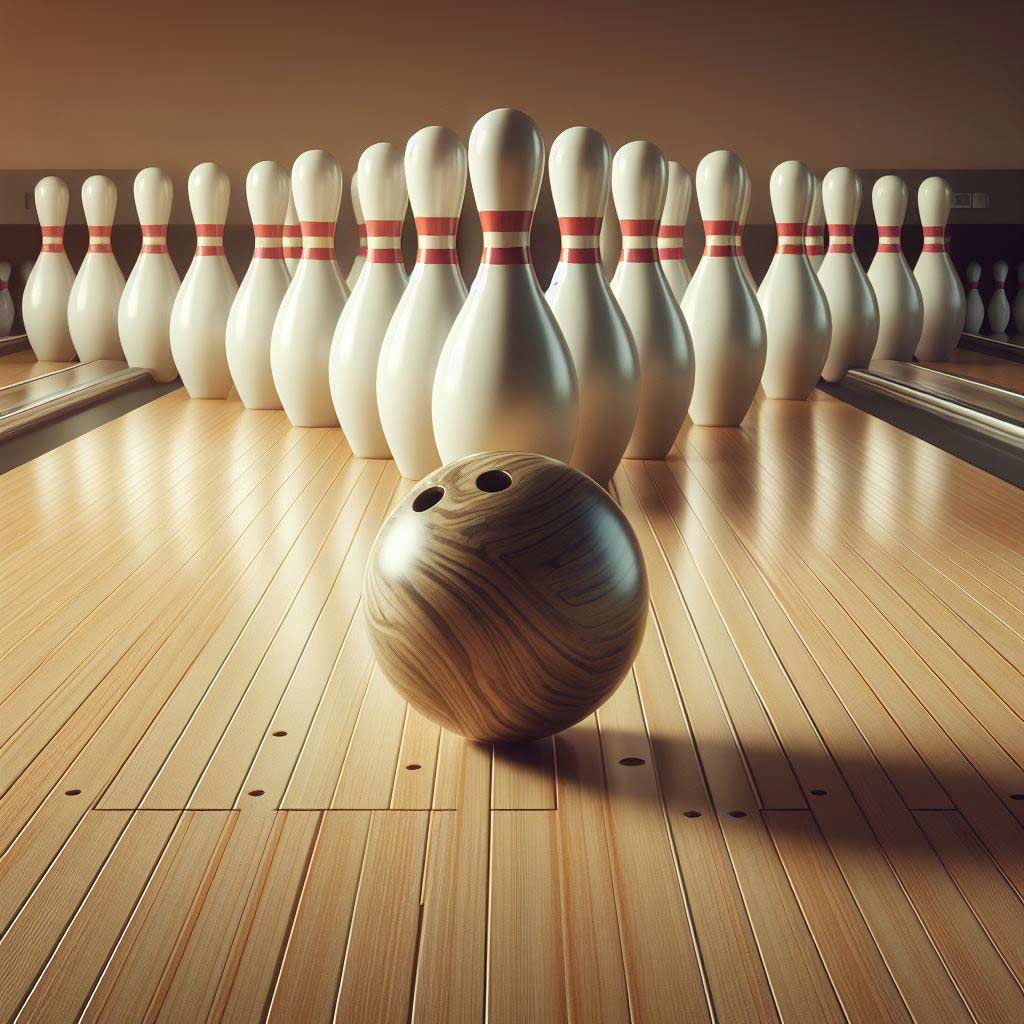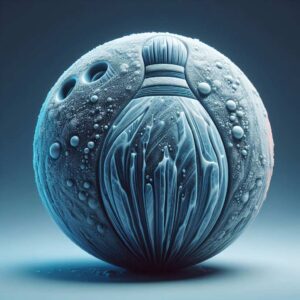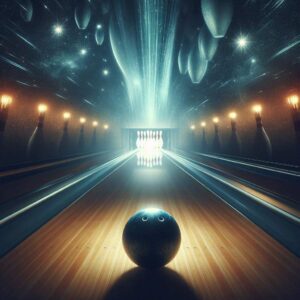Bowling is one of the most popular sports and recreational activities around the world. People of all ages enjoy hitting the bowling alleys for a night out with family or friends.
According to statistics, there are over 4,500 bowling centers and over 70,000 lanes for bowling in the United States alone. But have you ever wondered – what exactly are bowling lanes made out of? What materials go into constructing the surface we roll balls down to knock over pins?
The specialized lanes that form bowling alleys are precisely engineered using various materials to create the ideal playing surface. In this article, we’ll break down the components of standard ten-pin bowling lane construction and discuss the primary materials used.
What is the Deck of a Bowling Lane Made Of?
The bowling lane deck refers to the main wooden or synthetic flooring surface that the bowling ball rolls across. The lane decking is usually constructed using maple hardwood boards or manufactured synthetic materials.
Maple Hardwood
Traditionally, maple hardwood has been the premier material used for constructing bowling lane decks. Maple possesses an ideal combination of physical characteristics including strength, flexibility, hardness, and shock absorption. Here’s a closer look at why maple works so well:
- Durability: Maple is a dense, durable hardwood that can withstand repeated impact from bowling balls being rolled and dropped on it over decades of play. The hardness of maple resists denting and deformation.
- Smooth, Consistent Texture: Maple wood has a fine, uniform grain that gives it a smooth surface texture. This allows bowling balls to roll smoothly and consistently without distortion. Other wood grains have more variation which impacts ball motion.
- Shock Absorption: While maple is hard, it still has some “give” to absorb vibrations and sound. This prevents excess bounce and helps balls stay on line. The flexibility and hardness of maple are perfectly suited to bowling lanes.
- Stability: The stability and strength of maple minimize warping or shifts over time. This maintains consistent ball rolls over the lifetime of the bowling lane.
Maple boards are laid and secured side-by-side to form the complete lane decking. High-quality lanes will use maple sourced from the hard sugar maple tree, known for its strength and smoothness. The maple boards are also refinished and recoated periodically to maintain the ideal surface.
Synthetic Materials
In more modern times, some synthetic materials have been introduced as alternatives to traditional maple boards for bowling lane decks. Some examples include:
- Plastic Laminates: High-pressure plastic laminate overlays can be adhered on top of the wood lane decking to provide a protective barrier and more durability. The plastic laminate surface is very hard and smooth.
- Resin Composites: Some alleys use various resins combined with other materials to create a synthetic lane surface alternative. Resin materials like polyester or epoxy can be customized.
- Phenolic Materials: Phenolic was one of the first synthetic substitutes for wood lanes. It provides an extremely hard and durable surface. However, phenolic lanes have decreased in popularity due to high costs.
Synthetic lane materials have the advantage of even greater durability and consistency. However, some bowlers complain that certain synthetics change ball motion characteristics compared to traditional maple lanes. Overall, maple wood remains the most popular choice for serious bowlers.
Lane Oil Patterns and Coatings
The bowling lane decking provides the foundational surface. However, there are also specialized oil patterns and coatings applied to the lanes to affect ball motion and protect the wood.
Lane Oil Patterns
Synthetic or petroleum-based lane oil is applied to bowling lanes in specific patterns to control the ball path and challenge bowlers. Some examples of lane oil patterns that alter ball hooks include:
- House Shot: A relatively easy pattern with more oil in the middle that helps balls stay straight. Common for recreational bowling.
- Sport Shot: Designed for league play with a flatter oil pattern that presents more challenge.
- Challenge Patterns: Very difficult patterns like the PBA Wolf Pattern that require perfect precision.
The oil patterns influence ball traction, angle of entry, backend reaction, and more. Competitive and recreational bowlers alike must adapt their technique to the given lane conditions.
Lane Coatings
Special transparent coatings are also applied to protect the wood lanes and fine-tune ball motion. Some popular options include:
- Urethane Coatings: Offer a smooth surface and allow stable, predictable ball hooks.
- Reactive Resin: Absorbs oil better for strong backend ball reaction sought by competitive bowlers.
- Wax Coatings: Provide a slick surface that makes balls hook less with a muted reaction.
Regular resurfacing and reoiling of the lanes is needed to maintain optimal ball roll and bowling conditions. The right combinations of lane materials, oil patterns, and coatings make for exciting and challenging bowling!
Why Use Maple for Bowling Lane Construction?
As discussed earlier, maple has been the gold standard wood for bowling lanes throughout history. But what specifically makes maple so well suited to the needs of bowling lanes?
Hardness and Durability
Maple is one of the hardest domestic hardwoods available. With a Janka hardness rating of 1,450 lbf, maple is over 3 times harder than pine. This hardness and density allows maple boards to withstand decades of force from rolling bowling balls and absorbing dropped balls from great heights after strikes.
Maple’s durability also withstands repeated oiling, resurfacing, and recoating of lanes over many years. While scratches and dents can occur, quality maple lanes hold up remarkably well under heavy use.
Shock Absorption
While maple is hard, it still has enough give and flexibility to absorb vibrations and impacts. This becomes important for absorbing the shock of bowling balls rolling down the lane. Too much bounce could deflect balls off their intended path.
The ideal combination of strength and flex in maple protects the structural integrity of the lane while allowing proper ball motion. Soft woods would dent and deform too easily. Harder exotic woods would split and crack over time.
Consistent Grain Texture
The fine, uniform grain patterns of maple deliver a smooth, consistent texture optimal for bowling balls. Materials with more irregular grains cause friction and distortion to balls rolling down the lane.
Maple has just the right grain texture – not too slippery but not causing resistance either. This allows balls to roll true without hooking or curving unexpectedly due to inconsistencies in the wood surface.
Stability and Minimal Expansion
Maple wood also has minimal expansion and contraction even in environments with large humidity fluctuations. This prevents warping or shifting that could alter the ball path over time. Other woods expand and shrink much more with changes in moisture.
Furthermore, maple has strong structural stability that prevents loosening or separation of boards. This maintains the integrity of the lane surface across seasons and years of bowling events.
Bowling aficionados insist that maple provides the perfect surface for true and consistent ball motion. That’s why many serious or professional bowlers still consider maple lanes superior to synthetic alternatives. For high performance bowling, maple rules!
Other Bowling Lane Components and Materials
While the lane decking itself represents the primary component, various other elements like gutters, pins, and foul lines complete a regulation bowling lane setup.
Lane Gutters
Gutters run along each side of the lane deck to collect errant balls and keep them from rolling into other lanes. Modern bowling alley gutters consist of a plastic or metal lining that runs along a trough recessed below the lane surface. Sensors detect when a ball enters the gutter to mark the shot as a miss.
Bowling Pins
Skinny bowling pins have evolved quite a bit over history in terms of materials and design. Modern bowling pins are crafted from a plastic called Textolite made from paper, fabric, and a resin binder. This makes pins more durable yet still lightweight at around 3.5 lbs.
Foul Line and Approach Area
The foul line demarcates the starting point of the lane where bowlers must release the ball. The approach area leading up to the foul line allows bowlers to gain speed and momentum before their shot. This area is crafted from durable synthetics like laminate flooring.
Pinsetter Machines
One of the most mechanically complex aspects of modern bowling alleys is the automated pinsetter machines. These large contraptions swiftly clear downed pins and reset standing pins after each bowl. Pinsetters involve complex components like kicking rods, sweeping arms, gear motors, and more.
Underlane Components
Underneath the visible lane decking lies an intricate support structure including crossbeams and suspension components. These provide the proper foundation and shock absorption.
Advanced computerized scoring systems have also been integrated into many modern bowling alleys. However, the physical construction of quality maple lane decks, gutters, pins, and approach areas remains vital for an optimal bowling experience.
Conclusion
Whether you’re a seasoned league bowler or an occasional recreational player, the construction and materials of bowling lanes impact your game.
Traditional maple hardwood remains the gold standard for decking due to its optimal blend of hardness, smoothness, shock absorption, and stability. For this reason, many professional and high-level amateur events exclusively use maple lanes.
However, continued innovations in synthetic lane materials and computerized scoring systems demonstrate the evolution of bowling technology.
Lanes made of durable plastics and resins offer greater customization options to proprietors updating aging wood lanes. Still, knowledgeable bowlers debate whether synthetics truly match the consistency and feel of maple.
At the end of the day, what matters most is the passion and fun that strikes up every time you enter the bowling alley. As you gear up for your next game, spare a thought for the specialized maple boards or synthetic surfaces that make up the lanes we roll our strikes down. With quality construction and care, those lanes will keep bowlers coming back for generations more of bowling enjoyment!
So lace up your shoes, grab a shiny ball, and head down to your local bowling alley to test your skills on whichever types of lanes they offer. Just be careful not to cross over into the neighboring lane! With the right form and focus, you’ll be knocking down pins and having a blast – no matter what materials those lanes are made of.
Frequently Asked Questions
What wood are bowling lanes made out of?
Traditionally, bowling lanes have been made from maple wood boards. Maple provides the ideal blend of hardness, durability, and flexibility for bowling lanes.
How does bowling alley wood not break?
Quality maple wood has enough hardness and density to withstand repeated impact from bowling balls. Maple also has some flex which absorbs shock and vibration that could damage rigid woods. Proper construction and maintenance like resurfacing and oiling further protect the maple boards.
What kind of wood are bowling pins made out of?
Modern bowling pins are made from a hard plastic material called Textolite rather than wood. Textolite is a composite of paper, fabric, melamine, and phenol formaldehyde resin. It allows pins to be lightweight yet very durable.
What is wood in bowling?
Wood refers to the maple boards used to construct the lane decking that bowling balls roll on. Maple provides smoothness and consistency. Synthetic materials are also now used for lane decks but wood, especially maple, is considered ideal by many bowlers.
What are new bowling lanes made of?
Newly constructed bowling lanes may use traditional maple wood boards for the decking, or synthetic materials like plastic laminate overlays, and phenolic, and resin composites as alternatives. However, maple remains popular for new installations as well.
How do you refinish a wooden bowling alley?
Refinishing involves sanding down the maple boards to remove old finish and oils, filling any cracks or holes, then applying new sealant and lane oil in the desired pattern. Periodic refinishing maintains optimal conditions.
How thick is bowling alley wood?
Bowling lane maple boards are typically around 1 inch thick. They are secured side-by-side on top of an underlane support structure. The maple boards are thick enough to withstand impact while remaining flexible.
Why do bowling balls crack when not used?
Sitting unused over time, bowling balls can dry out as the oils used in manufacturing evaporate. This causes the coverstock material to shrink and crack. Regularly wiping and oiling unused balls helps keep them in good condition.
What is the difference between wood and synthetic bowling lanes?
Wood lanes provide a traditional feel many bowlers prefer. Synthetic materials offer very smooth, consistent performance but some dislike the feel. Synthetics can be more customized for speed, oil absorption, etc. But wood, especially maple, is considered the gold standard by purists.





